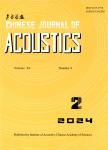Multipath matching pursuit using a cross-validation technique for sparse direction-of-arrival estimation with an acoustic vector array
作者机构:Acoustic Science and Technology LaboratoryHarbin Engineering UniversityHarbin 150001 Key Laboratory of Marine Information Acquisition and Security(Harbin Engineering University)Ministry of Industry and Information TechnologyHarbin 150001 College of Underwater Acoustic EngineeringHarbin Engineering UniversityHarbin 150001 School of Electronics and InformationJiangsu University of Science and TechnologyZhenjiang 212100 Science and Technology on Integrated Information System LaboratoryInstitute of SoftwareChinese Academy of SciencesBeijing 100190
出 版 物:《Chinese Journal of Acoustics》 (声学学报(英文版))
年 卷 期:2023年第42卷第2期
页 面:153-170页
核心收录:
学科分类:08[工学] 082403[工学-水声工程] 0824[工学-船舶与海洋工程]
基 金:supported by the National Natural Science Foundation of China(52171333)。
主 题:multipath estimation underwater
摘 要:High-resolution direction-of-arrival(DOA)estimations and the starboard ambiguity of moving underwater targets have always been key issues in underwater acoustic array signal processing.Compared with sound pressure arrays,vector arrays have natural advantages with respect to solving the starboard ambiguity problem and obtaining higher processing gains.Traditional high-resolution DOA estimation methods such as Capon have disadvantages such as being unable to resolve coherent sources,requiring multiple snapshot processing,and being sensitive to array manifold errors.High-resolution DOA estimation and the starboard ambiguity of moving underwater targets have always been challenging research topics.On one hand,maneuvering underwater targets reduce the coherence time of the received signals,which ultimately leads to poor performance when using high-resolution DOA estimation technologies based on the covariance matrix of the received signal.On the other hand,traditional DOA estimation technologies based on sound pressure arrays have the problem of port and starboard ambiguity,which can be solved by maneuvering the sonar platform.However,maneuvering the sonar platform can impair the coherence of the received signal,on which some algorithms rely.This approach greatly limits the combat effectiveness and performance of the platform.Given the aforementioned problems and taking advantage of the target sparsity,a cross-validation multipath matching pursuit technique based on the sparse DOA estimation of an acoustic vector array is proposed in this article for sonar observations.The proposed algorithm uses cross-validation technology to achieve a sparse DOA estimation with an unknown number of targets in a sonar observation scene.Compared with the conventional acoustic vector array-based Capon algorithm,the proposed algorithm can achieve a sparse DOA estimation and high-resolution capability with small numbers of snapshots or even single snapshots.The effectiveness of the proposed algorithm is verified via simulations and sea trial data processing.



